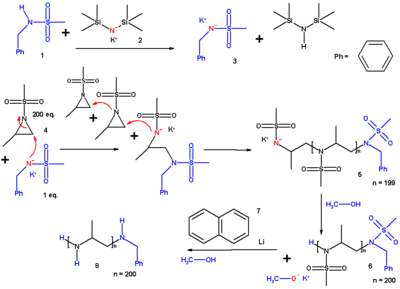Ring-opening polymerization

In polymer chemistry, ring-opening polymerization is a form of chain-growth polymerization, in which the terminal end of a polymer acts as a reactive center, where further cyclic monomers join to form a larger polymer chain through ionic propagation. The treatment of some cyclic compounds with catalysts brings about cleavage of the ring followed by polymerization to yield high-molecular-weight polymers. Exemplary polymers produced by this method include:
- Some polyamides from lactams:
- PA 6: Polycaprolactame from caprolactam
- PA 12: Polylauroamide from lauryllactam
- Some Polyesters from lactones:
- PCL : Polycaprolactone from caprolactone
- Polyethers from cyclic ethers:
When the reactive center of the propagating chain is a carbocation, the polymerization is called cationic ring-opening polymerization.
When the active center is a carbanion, the reaction is an anionic ring-opening polymerization. This is the case of the polypropylene oxide.
A different type of ring-opening polymerization, based on olefin metathesis, uses catalysts rather than cationic or anionic propagation.
One example of an anionic ring-opening polymerization is the living polymerization of the aziridine N-methanesulfonyl-2-methylaziridine with the sulfonamide N-benzyl methanesulfonamide (1) and potassium hexamethyldisilazide (2)(Fig. 1).[1] The disilazide actives the anionic initiator by proton exchange which reacts in chain initiation with an aziridine monomer in a ring-opening reaction (DMF, 40°C). In the chain propagation step the negatively charged end of the growing polymer chain continues to react with monomer until it is depleted. The reaction is chain terminated when methanol is added and the active chain end is destroyed. The polymerization is considered living because the polydispersity is low and no evidence is found of branching. In this particular concept the sulfonyl groups can be removed by organic reduction with naphthalene (7), lithium metal and methanol to the free polyamine 8. This procedure offers an alternative to a cationic ring-opening polymerization of oxazolines with anionic initiators and subsequent acid hydrolysis of the acyl groups.
See also
References
- ↑ Living Ring-Opening Polymerization of N-Sulfonylaziridines: Synthesis of High Molecular Weight Linear Polyamines Ian C. Stewart, Cameron C. Lee, Robert G. Bergman, and F. Dean Toste J. Am. Chem. Soc.; 2005; 127(50) pp 17616 - 17617; (Communication) doi:10.1021/ja0554357 Abstract Article link
- ↑ Bhangale, Atul; Kathryn L. Beers ‡, and Richard A. Gross *† (2012). "Enzyme-Catalyzed Polymerization of End-Functionalized Polymers in a Microreactor". Macromolecules,.
- ↑ Bhangale, Atul; Santanu Kundu † William E. Wallace †, Kathleen M. Flynn †, Charles M. Guttman †, Richard A. Gross *‡, and Kathryn L. Beers *† (2010). "Continuous Flow Enzyme-Catalyzed Polymerization in a Microreacto". Journal of American Chemical Society.